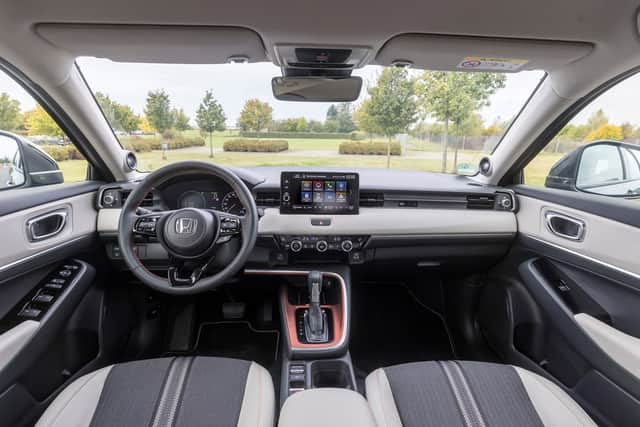2021 Honda HR-V hyrbid review: It’s nice to be nice


When one of the highlights of your new car is an L-shaped air vent at either side of the dashboard, you might think that there’s not going to be much positive to talk about. It’s true that the new Honda HR-V might isn’t the most exciting new car to be launched this year, but there has to be more to it than some funky air vents, hasn’t there?
It certainly needs something else, as a quick look at competing cars soon turns into a far longer look - I can list 30 potential rivals, from obvious choices such as the Ford Puma, Peugeot 2008 and Nissan Juke to more niche products like the Jeep Renegade.
Honda HR-V engine and performance
Advertisement
Hide AdAdvertisement
Hide AdHonda tends to make a more innovative stand than most of its rivals, and that starts with the engine. Hybrid technology is well established, but the HR-V’s clumsily named ‘e:HEV’ system has a trick up its sleeve that Honda claims balances emissions, economy and performance better than the competition.
Under the bonnet is a conventional 1.5-litre petrol engine that’s supported, like every other hybrid, by an electric motor. Honda’s trick is to be able to entirely disengage one or the other from the driveline. That sounds like an obvious thing to do, but it’s something nobody else is doing. That means motorway driving can be petrol-powered but without any drag on the engine from the electric motor, which saves fuel. Likewise, in pure electric modes, the engine is decoupled which reduces friction losses in the system and lets you go further on each kWh of energy.


Does it work? After a day driving the new model around, including pushing it to its maximum speed along an autobahn for some time, the car’s trip computer showed a result of 53.0mpg - slightly better than the official WLTP economy figure of 52.3mpg. Given that the car was punished rather more than the average UK driver might manage, it seems reasonable to expect more frugal motorists to easily achieve 60mpg.
Despite the impressive economy, performance hasn’t been limited too much. According to Honda, the 0-62mph dash is dealt with in 10.7 seconds but, as with so many electrically powered cars, it feels rather more urgent than that at urban speeds. There’s a zestiness to the acceleration that’s immediate and impressive, but it runs out once speed increase to 50mph or so. On Germany’s fast autobahns, acceleration at higher speeds is measured in glacial terms, but it’ll be easy to live with in the UK.
Germany’s roads tend to be in better condition than ours, but the HR-V tackles faster routes with aplomb, casually gliding over longer undulations, although there’s always a little background jiggle. The sharper, more frequent dips, cracks and potholes in town upset it a little more, but there are far worse in the segment.
Honda HR-V interior
It’s very quiet in the cabin. Mostly. The HR-V favours electric power at low speeds, so the engine is rarely in use unless there’s high demand. When there is high demand, ear defenders might be in order, if not to block the volume (although it is pretty loud) then to block the grating, dreary engine note. Happily, it’s kept out of earshot most of the time, even along the motorway, where even the relatively low levels of wind and tyre noise drown it out.


The rest of the cabin is ace. It doesn’t look that smart in the pictures, but it all works effortlessly in the real world. Space in the front is fine for all, but those in the rear don’t get treated quite so well; there’s acres of legroom when the seat is set for this 5’10” driver, but headroom is very tight. While you can’t lower the rear seats, they do all sorts of other movements. Called “Magic Seats”, Honda’s created something useful for families by allowing them to fold, flip and move around in myriad ways. It offers a genuinely flexible way of extending the load area, leaving enough space to fit a bike in the back or stand a tall pot plant upright. Handy when it’s got an otherwise small boot; at 319 litres, there’s 185 litres less than you’ll find in a Nissan Qashqai and it’s 137 litres behind the Ford Puma’s cargo area.
And then, of course, there are those vents. The small L-shaped outlets sit at the edge of the dashboard, right by the side windows, and create a gentle breeze throughout the cabin rather than blowing air directly on your face. They also promise to keep the car cool in the summer, creating an air curtain by the windows to keep direct sunlight from heating the cabin.
Advertisement
Hide AdAdvertisement
Hide AdA miserable grey day in October wasn’t the best time to put that to the test but, if it works as promised, it’ll be nice. This sums up the HR-V nicely. It’s nice.
Honda HR-V e:HEV Advance
Price: £29,210; Engine: 1.5-litre, petrol, two electric motors; Power: 127bhp; Torque: 187lb ft; Transmission: Single-speed automatic; Top speed: 105 mph; 0-62 mph: 10.7 seconds; Economy: 52.3 mpg; CO2 emissions: 122 g/km
Comments
Want to join the conversation? Please or to comment on this article.